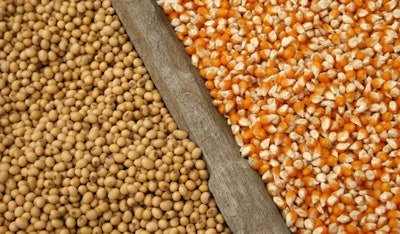
Scott Irwin of the University of Illinois shares his insights into the commodity markets for 2022.
PODCAST: Factors that will affect the 2022 corn, soybean outlook (7:28)
Ann Reus: Hello and welcome to the Feed Strategy podcast. I’m your host, Feed Strategy senior reporter Ann Reus.
Today I’m speaking with Scott Irwin, the Laurence J. Norton Chair of Agricultural Marketing at the University of Illinois Urbana-Champaign. He’s here to talk about his outlook for the commodity markets this year.
Hi Scott, thanks for joining me.
Scott Irwin: Glad to be here.
Reus: Let’s talk about the corn and soybean harvest from this season. What can you tell me about the crop conditions and yield that farmers saw?
Irwin: Well, it was an interesting year, for sure. I think that probably the best way to describe it is, it ended up being basically an average year, but with a bit of disappointment in the eastern Corn Belt and a bit of pleasant surprise in the western Corn Belt about where final yields ended up compared to expectations in, say, in August.
Reus: What are your thoughts on the most recent report on World Agriculture Supply and Demand Estimates? It seemed to me like there was some disagreement between the USDA and some economists on the pricing and maybe some demand that we’ll see for corn and soybeans.
Irwin: I think the really intriguing part of that report was the drop in global soybean ending stocks, mainly due to estimates of damage in South America to soybean production, and also potentially later to corn. Clearly, soybean prices have reacted to the weather news from South America a lot since December as they’ve entered their critical growing period. So, I think an assessment of the final ding to soybean yields in South America is obviously a big deal.
Reus: Yeah, what can you tell me about the weather conditions in South America, and how much do you think that’ll affect the world markets?
Irwin: An interesting mix in South America: Let’s take Brazil. The center-west area of the country, which is their biggest soybean producing area, has been at least near normal to good conditions. But there’s been a pretty severe drought in the southern Brazil growing areas that have been stretched into the pampas-growing regions of Argentina. And it’s that balance that people are trying to get a handle on, and it clearly seems that the market has settled on some fairly significant reductions in yields overall, because conditions are so bad in the droughty areas.
Reus: What’s your outlook for the longer term on grain costs? Will they stay high or will they start to come down at some point and stabilize?
Irwin: Well, what we see historically on cost, let’s kind of divided into different areas. Let’s first consider kind of three main areas: seed, fertilizer and rent. And what we see is that seed costs rarely ratchet down after ratcheting up, so those costs are likely to stay high. Fertilizer tends to move more with the level of, in particular, corn prices. So, if corn prices come down, we’ll see some relief on fertilizer prices. Cash rents, probably more similar to seed than fertilizer. If grain prices start coming down, we know that they’re sticky coming back down. There will be downward pressure, potentially, eventually, on cash rents. But that takes time, and it’s sticky on the way down. All that says is the picture overall is that any reductions in costs that we’re going to see will be, I think, pretty limited here in the near term.
Reus: OK, you talk about South America a little bit, but what are some of the other main global factors affecting grain supply, demand and pricing?
Irwin: Well, as a it has been for a number of years now, the No. 1 factor is demand from China and trying to suss out what exactly is going to be their aggregate level of demand for importing corn and soybeans, and then how are they going to source it. So that’s the No. 1 factor. And then the No. 2 on the supply side is, what do exportable supplies from our biggest competitors look like? For corn, that’s mainly three places: Brazil, Argentina, and the Ukraine. And for soybeans, it’s mainly Brazil and Argentina.
Reus: What are some commodity trends that animal feed producers need to keep an eye on this year?
Irwin: No. 1, we’ve been talking about what is going to be the final crop size in South America, on both corn and soybeans. This will have a major impact on the level of corn and soybean prices until we get the next harvest in North America. So that’s, that’s No. 1. No. 2, the production in other competing countries, mainly Ukraine. No. 3, a really big one, is what is Chinese buying of feed grains – corn in particular – going to look like in 2022. A major wildcard. And finally, No. 4, the macroeconomic situation as it relates to inflation, and how this impacts the price of livestock and input costs – in particular, feed.
Reus: OK, well, thanks for all those great insights, Scott. It will be interesting to see how the commodity markets play out this year.
Irwin: Absolutely. I mean, it’s ever changing. It is never boring, and I’m sure 2022 won’t be either.
Reus: I’m sure, too. I’d like to thank all the listeners for tuning in. I’m Ann Reus for Feed Strategy.












